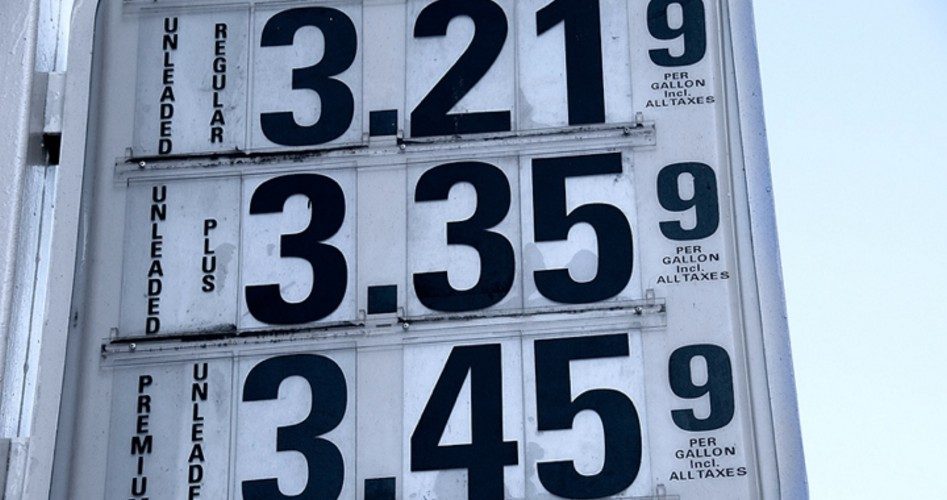
Despite predictions to the contrary, the price of gas over the July 4 weekend dropped by two cents per gallon, confounding seers who were looking at gas approaching $4 a gallon. Those prognosticators were guilty of “straight-line thinking in a curvilinear world” — meaning that since gas this year was 20 cents a gallon more than a year ago, they believed it would continue to go up steadily for the foreseeable future.
With political disruptions in Iraq and Syria seriously reducing their contributions to the world’s oil supplies, one would think that prices would have to go straight up.
One would be wrong.
On July 4, Bank of America reported that U.S. production of crude oil (along with the liquids separated from natural gas) “surpassed all other countries this year with daily output exceeding 11 million barrels [per day] in the first quarter.” Francisco Blanch, BofA’s head of commodities research, told Bloomberg,
The U.S. increase in supply is a very meaningful chunk of oil. The shale boom is playing a key role in the U.S. recovery [from the Great Recession].
If the U.S. didn’t have this energy supply, prices at the pump would be completely unaffordable.
The nearly exponential growth in oil production, thanks to the free market’s invention and development of fracking technology, has put the United States firmly on the path of energy independence. As we become energy independent, disruptions in the supply chain from the Middle East will matter less and less.
Texas and North Dakota — which Professor Mark Perry calls “Saudi Texas” and “Saudi Dakota” respectively — are now producing almost half of all U.S. oil, and would rank as the fifth largest oil producing country as a separate nation. The growth in production is astonishing, according to Perry:
A decade ago the combined conventional crude oil production in the states of Texas and North Dakota … represented less than 21% of total U.S. crude oil output.
By 2008, the combined crude oil output in the two states … were producing one-third of all U.S. crude oil.
In eight out of the last nine months, their combined share exceeded 47% of all U.S. oil.
Perry predicts that it will exceed 50 percent sometime before the end of the year. And that prediction could come back to embarrass him, if the International Energy Agency (IEA) is correct. The IEA is estimating that total U.S. crude oil production (currently at 8.4 million bpd) will continue to soar, exceeding 13 million barrels per day in less than five years. That 50-percent increase in oil production would mean that the United States could be producing nearly 80 percent of its domestic needs for energy, closing in on energy independence.
In the very short run, gas prices will remain higher than they should be, thanks to the disruptions of supply in the Middle East, but with the continuing success of fracking making shale oil deposits now available with current technology, prices may reasonably be expected to decline further over time. Blanch admitted as much to Bloomberg:
The shale production story [in the United States] is bigger than Iraqi production, but it hasn’t made the impact on prices you would expect.
Typically such a large energy [production] growth should bring prices lower but in fact we’re not seeing that because the whole geopolitical situation outside the U.S. is dreadful.
Those involved in capitalizing on the fracking revolution, however, are taking a much longer view. The annual investment in oil and gas development and production hit a record $200 billion this year, one-fifth “of the country’s total private fixed-structure spending for the first time,” said Blanch.
The explosion in the oil patch is doing much to offset the otherwise nearly stagnant economy. In the last 10 years, direct jobs in the patch have almost doubled, while “indirect” jobs that support the industry have almost tripled in that same time period. As Professor Perry noted: “No other sector … has added as many jobs for American workers or made as much of an overall economic contribution to the US economy as the oil and gas sector.”
Citizens often don’t know how well they have it here. At present the average cost of gasoline is $3.69 a gallon for regular. In Norway it’s an astounding $9.79 a gallon, while in Germany it’s $8.50, and in England a gallon of petrol is $8.25.
The only thing that will keep the price of gas from continuing its two-year decline is government, either through restrictions on energy development or through increased taxation. At present about $2.37 of that $3.69 represents the cost of crude oil. Refining costs are about $.45 a gallon, while distribution, marketing costs, and profits (estimated to be between eight and 15 cents per gallon) cost another $.33 a gallon. Taxes (federal and state) take up the balance: $.42 a gallon. Federal excise taxes are $.184 cents a gallon, while state taxes average about $.24 cents a gallon. If gas continues to drop in response to the natural laws of supply and demand (greater supply means greater demand thanks to the lower price), the temptation to raise state and federal excise taxes will become overwhelming.
In Germany, for instance, half the cost of a gallon of gas is due to taxes. In Great Britain the tax take on a gallon of gas is more than 60 percent. In Sweden it’s even higher.
At present, however, the laws of supply and demand are providing an enormous advantage to American drivers compared to their counterparts abroad. And they continue to confound the experts predicting ever higher prices at the pump as well.
A graduate of Cornell University and a former investment advisor, Bob is a regular contributor to The New American magazine and blogs frequently at www.LightFromTheRight.com, primarily on economics and politics. He can be reached at [email protected].



